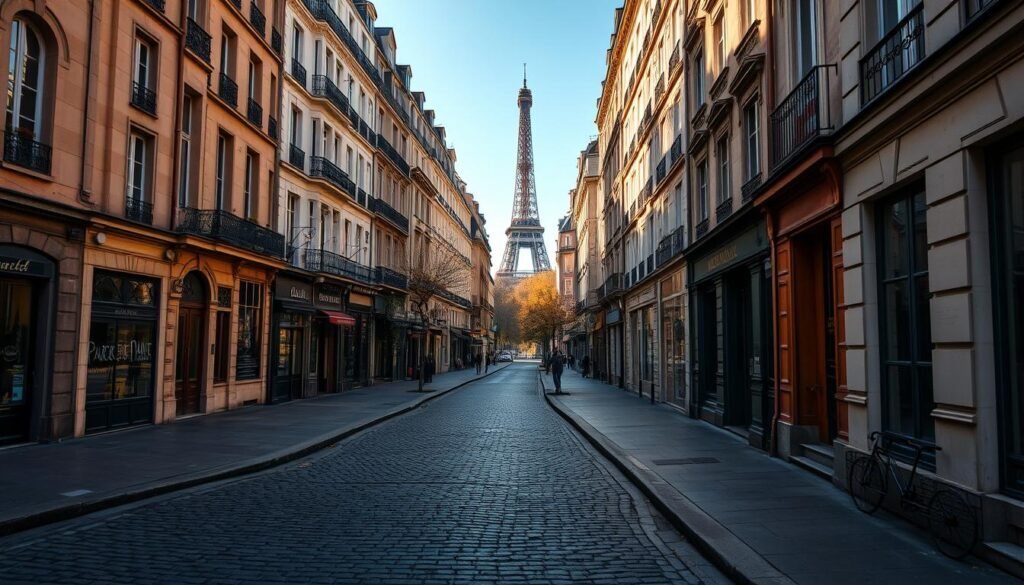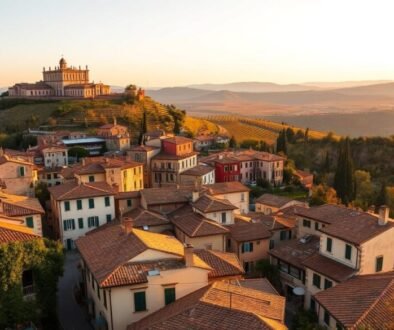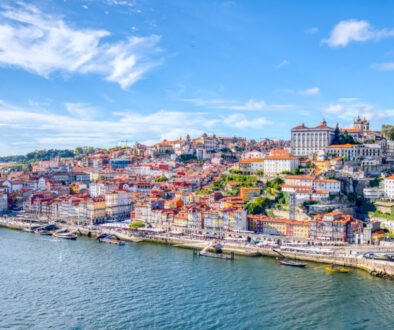Historic Walks: Discovering the Hidden History of Paris
This article may contain affiliate links. If you click on these links and make a purchase, we may receive a small commission at no extra cost to you. This helps support our website and allows us to continue to produce content like this. Thank you for your support!
Step into a city where every cobblestone tells a story and every corner whispers secrets of the past. Paris, the heart of France, is a treasure trove of history, architecture, and culture. From the iconic Eiffel Tower to the charming Latin Quarter, this city invites you to explore its timeless beauty.
Embark on a journey through ancient streets and hidden alleys. Discover the art and culture that have shaped this region for centuries. Whether it’s the grandeur of Notre-Dame or the cozy cafes of Montmartre, every step offers a new experience.
Join us as we uncover the mysteries behind Paris’s historic landmarks. Learn about the people and events that have left their mark on this vibrant city. Get ready to immerse yourself in a world where history comes alive.
Exploring Paris: A City of Hidden History
Walk through a city where the past and present blend seamlessly. Every street and quarter holds stories that span centuries. From the grandeur of the Eiffel Tower to the charm of the Latin Quarter, this region invites you to uncover its secrets.
Paris is a world where history and modern life coexist. The architecture tells tales of kings and revolutions, while cozy cafes and bustling markets reflect the vibrant culture of today. It’s a place where every corner offers a new experience.
Hidden alleys and secret spots add to the city mystique. These lesser-known areas, shaped by government planning and urban development, reveal a side of Paris that many miss. It’s an effort worth making to explore these gems.
- Discover quaint alleys that feel like stepping back in time.
- Visit historic sites that showcase the art and culture of the region.
- Enjoy the vibrant food scene, where every meal feels like a celebration.
As you plan your journey, prepare to dive deeper into the stories behind iconic landmarks and architectural wonders. The next sections will guide you through the history and culture that make this city truly unforgettable.
Iconic Landmarks and Their Stories
Uncover the stories behind the most iconic structures in the world. From the towering Eiffel Tower to the majestic Notre-Dame, each landmark reflects the art and history that shaped this vibrant city.
The Eiffel Tower, built in 1889, was initially a temporary exhibit for the Universal Exposition. Today, it stands as a symbol of innovation and attracts millions of visitors each year. Its three levels offer breathtaking views of the city, making it a must-visit for anyone exploring the region.
Notre-Dame Cathedral, with its Gothic architecture, has been a cornerstone of the city for over 850 years. Its intricate designs and stained glass windows tell stories of faith and resilience. Despite the 2019 fire, restoration efforts continue to preserve this historic gem.
Other landmarks like the Arc de Triomphe and the Basilica of Sacré-Cœur also hold fascinating tales. The Arc, built to honor Napoleon’s victories, stands at the heart of the street known as the Avenue des Champs-Élysées. Meanwhile, Sacré-Cœur, perched atop Montmartre, offers panoramic views and a serene experience.
- Discover how the Eiffel Tower became a global icon of architecture.
- Learn about the hidden narratives behind Notre-Dame’s Gothic design.
- Explore the cultural significance of the Arc de Triomphe and Sacré-Cœur.
These landmarks are more than just structures; they are windows into the culture and history of the world. Whether you’re a first-time visitor or a seasoned traveler, each site offers a unique experience that brings the city’s past to life.
Uncovering Secret Spots in the City
Dive into the lesser-known corners where history whispers its secrets. Beyond the bustling streets and iconic landmarks, this city hides treasures waiting to be discovered. These hidden gems offer a glimpse into the history and culture that shaped the region.
Parc des Buttes-Chaumont is one such spot. Nestled in the 19th arrondissement, this park features the Temple de la Sibylle, inspired by ancient Roman architecture. It’s a peaceful retreat from the city’s hustle, offering stunning views and a touch of art.
Canal Saint Martin is another hidden gem. This area is a favorite among locals, with its charming bridges and trendy cafes. It’s a perfect place to soak in the world of everyday life in the city.
For a unique experience, explore La Petite Ceinture. This disused railway line is now a green pathway, offering a quiet escape. It’s a reminder of the city’s industrial past and a testament to urban renewal.
- Visit Parc des Buttes-Chaumont for its serene beauty and historical charm.
- Stroll along Canal Saint Martin to see the city from a local’s perspective.
- Walk La Petite Ceinture to uncover a piece of forgotten history.
These secret spots provide a deeper connection to the city. They reveal stories that go beyond the usual tourist trails. Take the effort to explore them, and you’ll discover a side of the world that’s truly unforgettable.
Historic Architecture and Timeless Streets
Discover the layers of history etched into every street corner. The city’s architecture tells a story of evolution, from medieval designs to modern masterpieces. Each building and street reflects the history and culture that shaped this vibrant region.
Medieval remnants can still be found in the layout of narrow alleys and hidden courtyards. These designs were influenced by the need for defense and space efficiency. Over the years, the city expanded, blending old and new styles seamlessly.

Louis XIV’s reign brought Baroque grandeur, while Baron Haussmann’s 19th-century renovations introduced wide boulevards and uniform facades. These changes transformed the city into a model of urban planning. Today, these streets are bustling with life, yet they retain their historic charm.
Preservation efforts ensure that iconic structures like Notre-Dame and the Eiffel Tower remain intact. These landmarks are not just symbols of the city but also reminders of its resilience. They inspire admiration and connect the present to the past.
- Explore the Latin Quarter, where medieval architecture meets modern cafes.
- Stroll along the Champs-Élysées, a street steeped in history and elegance.
- Visit Place des Vosges, one of the oldest planned squares in the world.
Every corner of this city offers a glimpse into its rich history. From grand palaces to quaint hotels, the architecture tells a story of innovation and artistry. Take the time to explore these timeless streets, and you’ll uncover a world of beauty and inspiration.
The Eiffel Tower: A Beacon of Innovation and Art
Stand in awe of a structure that redefined modern engineering and art. The Eiffel Tower, completed in 1889, was initially built for the Universal Exposition. It marked the 100th anniversary of the French Revolution and quickly became a symbol of innovation.
Designed by Gustave Eiffel, this iconic tower was a marvel of its time. Its iron lattice structure showcased groundbreaking engineering techniques. At 324 meters tall, it was the tallest man-made structure in the world until 1930.
The Eiffel Tower’s design influenced art and architecture globally. Its sleek, industrial aesthetic inspired artists and designers. Today, it remains a testament to human creativity and ingenuity.
Originally slated for demolition in 1909, the tower was saved by its utility as a radio transmission tower. During World War I, it played a crucial role in military communications. This adaptability ensured its place in the city’s skyline.
Over the years, the Eiffel Tower has become a cultural icon. It attracts millions of visitors annually, making it one of the most visited paid monuments in the world. Its sparkling lights and romantic allure have cemented its status as a symbol of the city.
| Fact | Detail |
|---|---|
| Height | 324 meters |
| Construction Year | 1889 |
| Designer | Gustave Eiffel |
| Purpose | Universal Exposition |
| Annual Visitors | Over 7 million |
From its early days as a temporary exhibit to its current status as a global icon, the Eiffel Tower continues to inspire. Its blend of art and engineering makes it a must-see for anyone visiting the region. It’s a reminder of what humanity can achieve with vision and determination.
The Enchanting World of Paris
Immerse yourself in a city where every moment feels like a dream. Cobblestone streets wind through charming neighborhoods, leading to quaint cafés and intimate alleyways. Each corner reveals a new layer of magic, inviting you to explore its secrets.
This world is a blend of art, music, and culinary delights. From the soulful melodies of street performers to the aroma of freshly baked pastries, every sense is awakened. The city’s multifaceted personality shines through its vibrant culture and timeless beauty.
People from around the globe are drawn to this region for its enchanting vibe. Whether it’s a stroll along the Seine or a quiet moment in a hidden garden, the city offers an unforgettable experience. It’s a place where history and romance intertwine effortlessly.
Join the countless visitors who have fallen under its spell. Discover why this area continues to captivate hearts and minds. Let the magic of the city inspire your next adventure.
| Aspect | Detail |
|---|---|
| Cobblestone Streets | Charming and historic pathways |
| Quaint Cafés | Perfect for a leisurely afternoon |
| Art and Music | Vibrant cultural expressions |
| Culinary Delights | From pastries to gourmet meals |
The Evolution of Paris Through the Ages
From its ancient roots to its modern skyline, the city’s evolution tells a story of resilience and innovation. What began as a small settlement along the Seine has grown into a global icon of culture and architecture. Each era has left its mark, shaping the region into the vibrant hub it is today.
In 52 BC, the Romans established Lutetia, a Gallo-Roman town that laid the foundation for the city. Over time, it became a center of trade and art, with structures like the amphitheater and aqueduct showcasing Roman ingenuity. By the Middle Ages, the city had transformed into a bustling medieval hub, with the University of Paris emerging as a beacon of knowledge.
The Renaissance and Enlightenment periods brought further change. The city became a focal point for intellectual and artistic movements, influencing the world with its ideas. The French Revolution in 1789 marked a turning point, reshaping the city’s political and social landscape.
In the 19th century, Baron Haussmann’s urban planning transformed the city’s layout. Wide boulevards and uniform facades replaced narrow streets, creating the iconic Parisian aesthetic. This blend of old and new continues to define the city, offering a unique experience for visitors and residents alike.
- Explore the Roman roots of Lutetia and its lasting impact on the city.
- Discover how medieval Paris became a center of learning and culture.
- Learn about the Enlightenment and its influence on the world.
- Reflect on Haussmann’s urban planning and its role in shaping modern Paris.
Today, the city stands as a testament to its rich history. From ancient ruins to modern landmarks, every corner tells a story. As you walk its streets, you’ll see how the past continues to inspire the present, making it a truly timeless destination.
The Cultural Tapestry of the Latin Quarter
Step into the heart of intellectual and artistic brilliance in the Latin Quarter. This vibrant area has been a beacon of learning and creativity for centuries. Its cobblestone streets and lively atmosphere make it a must-visit in the city.
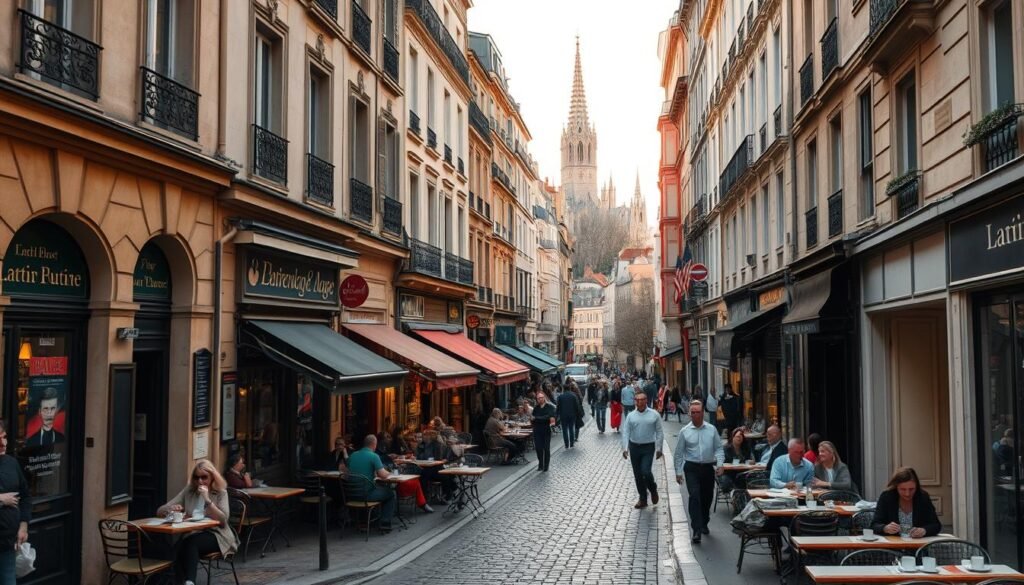
The Latin Quarter is home to the Sorbonne, one of the oldest universities in the world. Founded in 1257, it has shaped the minds of countless scholars. Nearby, the Panthéon stands as a tribute to great figures like Voltaire and Marie Curie.
Art and culture thrive here. The Jardin des Plantes offers a serene escape with its diverse plant species. The Musée de Cluny showcases medieval masterpieces, including the famous “Lady and the Unicorn” tapestry.
Every corner of the Latin Quarter tells a story. From the historic churches to the bustling cafés, this region blends tradition with modernity. It’s a place where the past and present coexist harmoniously.
- Explore the Sorbonne and its rich academic legacy.
- Visit the Panthéon to honor France’s greatest minds.
- Stroll through the Jardin des Plantes for a touch of nature.
- Discover the Musée de Cluny’s medieval treasures.
| Landmark | Significance |
|---|---|
| Sorbonne | One of the oldest universities in the world |
| Panthéon | Mausoleum honoring great French figures |
| Jardin des Plantes | Botanical garden with diverse plant species |
| Musée de Cluny | Museum showcasing medieval art and history |
The Latin Quarter is more than just a neighborhood; it’s a living testament to the city’s cultural and intellectual heritage. Whether you’re a history buff or an art lover, this area offers an unforgettable experience.
Literary and Artistic Influences in Paris
Explore the creative pulse that has shaped one of the world’s most artistic cities. Over the centuries, this region has been a magnet for writers, painters, and thinkers. Its streets and cafés have witnessed the birth of movements that changed the course of art and literature.
From the 19th century onward, the city became a hub for innovation. Figures like Marcel Proust and Pablo Picasso found inspiration in its vibrant area. Proust’s monumental work, “À la recherche du temps perdu,” redefined modern literature. Picasso, along with Georges Braque, pioneered Cubism, transforming the art world.
The café culture played a pivotal role in fostering creativity. Places like Café de Flore and Les Deux Magots were meeting spots for intellectuals. Writers like Jean-Paul Sartre and Simone de Beauvoir debated existentialism here. These salons became incubators for artistic and philosophical ideas.
Artistic movements like Surrealism and Fauvism also flourished. André Breton led the Surrealist movement, blending art and psychology. Meanwhile, Henri Matisse and André Derain introduced bold colors and simplified forms, defining Fauvism. These movements continue to inspire modern creators.
Today, the city’s artistic legacy lives on. Galleries, bookstores, and theaters celebrate its rich history. Whether it’s a contemporary exhibition or a classic novel, the creative spirit of this region remains alive. It’s a testament to the enduring influence of its literary and artistic pioneers.
| Movement | Key Figures |
|---|---|
| Cubism | Pablo Picasso, Georges Braque |
| Surrealism | André Breton, Salvador Dalí |
| Fauvism | Henri Matisse, André Derain |
| Existentialism | Jean-Paul Sartre, Simone de Beauvoir |
This city’s artistic and literary heritage is a treasure trove of inspiration. It’s a place where creativity knows no bounds, and every corner tells a story. For anyone passionate about art and literature, this region offers an unforgettable journey into the heart of human expression.
Culinary Delights in Paris
Indulge in a culinary journey where every bite tells a story. This city is renowned for its food, blending centuries-old traditions with modern innovation. From flaky croissants to decadent pastries, the flavors here are as rich as the region’s history.
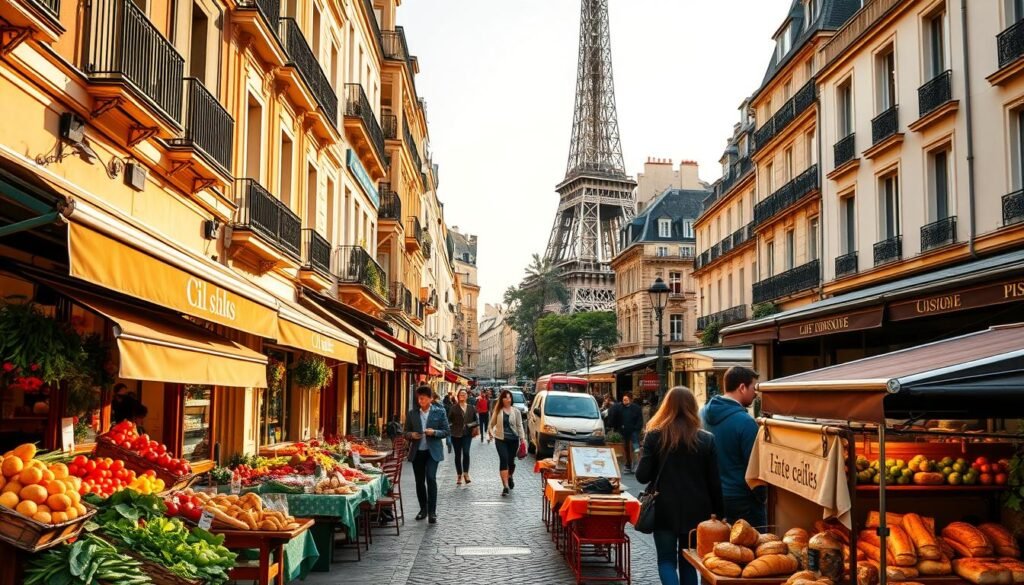
Paris has long been a global hub for fine dining. Its food scene is a testament to the world’s love for French cuisine. Local bakeries, like those led by acclaimed chef Nina Metayer, offer exquisite treats that delight both locals and visitors.
Signature dishes like the classic Quiche Lorraine and the indulgent Gateau Saint-Honoré showcase the city’s culinary mastery. Each bite reflects the passion and skill of the person behind the creation. The blend of tradition and creativity ensures that every meal is a memorable experience.
- Discover the rich history behind French cheeses, with over a thousand varieties to explore.
- Savor the iconic croissant, a symbol of French baking perfection.
- Experience the artistry of Nina Metayer, whose pastries have earned global acclaim.
Whether you’re dining in a cozy bistro or a Michelin-starred restaurant, the food here is a celebration of flavor. The city’s culinary scene invites you to taste the diverse and evolving flavors that have made it a world leader in gastronomy.
The Role of Government and Urban Planning in Shaping the City
The evolution of a city often reflects the vision and decisions of its leaders. Over centuries, the government has played a pivotal role in transforming urban landscapes. From historical reforms to modern policies, strategic planning has shaped the way people live, work, and interact.
During the reign of Louis XIV, the city began to take on a more structured form. Wide boulevards and grand squares were introduced, reflecting the monarch’s desire for order and elegance. These changes laid the foundation for future urban development.
In the 19th century, Baron Haussmann’s renovations revolutionized the urban landscape. His plan included the creation of wide avenues, improved sanitation, and the demolition of overcrowded neighborhoods. This bold approach not only modernized the city but also enhanced its functionality and beauty.
Modern urban policies continue to build on this legacy. Transparent information and participatory planning are now key priorities. Initiatives like neighborhood councils and citizen assemblies ensure that residents have a voice in shaping their communities.
Here are some key milestones in urban development:
- The annexation of surrounding suburbs in 1859 expanded the city’s area and population.
- Street width regulations in 1783 linked building heights to infrastructure design.
- Modern projects focus on preserving heritage while accommodating growth.
Strategic government decisions have also preserved the city’s cultural heritage. Landmarks like the Eiffel Tower and Notre-Dame are protected through careful planning and restoration efforts. These initiatives ensure that the city’s history remains alive for future generations.
As urban areas grow globally, the lessons learned here offer valuable insights. Transparent information and inclusive planning are essential for creating sustainable and vibrant communities. The world can look to this city as a model of how leadership and vision can shape the future.
Experiencing the Nighttime Wonders and Illuminations
As the sun sets, the city transforms into a glowing spectacle of lights and life. Known as the “City of Light,” it offers an unforgettable experience after dark. The streets come alive with a magical atmosphere, inviting you to explore its illuminated wonders.
One of the most iconic sights is the Eiffel Tower, which sparkles every hour after sunset. Its golden lighting, powered by 336 spotlights, creates a breathtaking display. The tower’s beacon, with a 50-mile range, adds to the night’s enchantment.
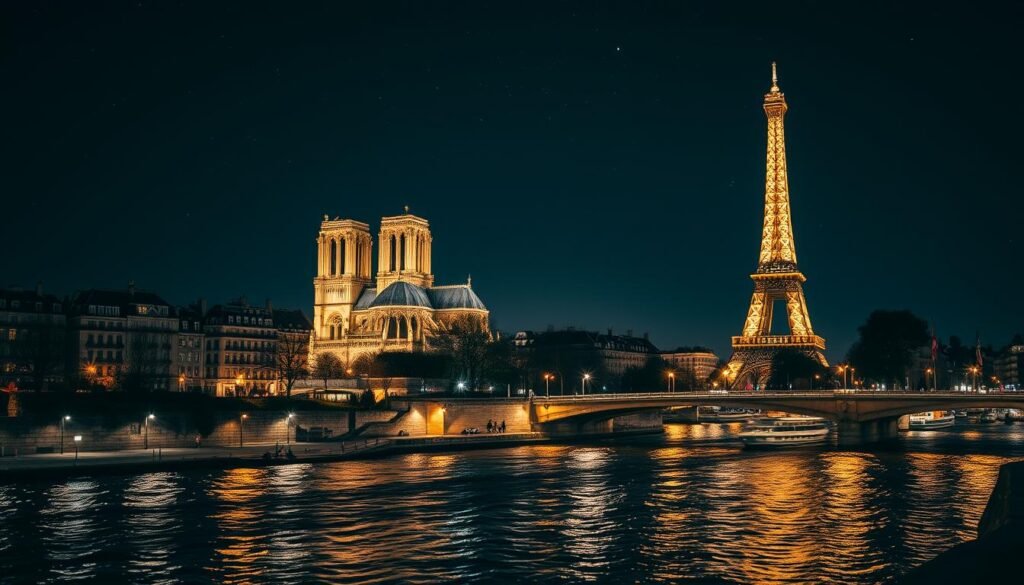
Strolling along the Seine River offers a serene yet vibrant experience. The water reflects the lights of landmarks like Notre-Dame and the Louvre, creating a picturesque scene. Evening cruises provide a unique perspective, blending history with modern charm.
Here are some must-see attractions to enhance your nighttime adventure:
- Witness the Eiffel Tower’s hourly sparkles, a symbol of the city’s innovation.
- Explore the Champs-Élysées, where the lights and energy create a lively ambiance.
- Visit Montmartre for a blend of art, history, and stunning views of the world below.
The nighttime environment also deepens the city’s cultural narrative. Illuminated monuments like the Arc de Triomphe and Sacré-Cœur tell stories of resilience and artistry. Each landmark becomes a beacon of history, shining brightly against the night sky.
Planning an evening walk is the best way to immerse yourself in this blend of light, art, and ambiance. The sounds of street musicians, the aroma of fresh pastries, and the rhythm of the city create a sensory feast. It’s an experience that lingers long after the night ends.
| Attraction | Highlight |
|---|---|
| Eiffel Tower | Hourly sparkles and golden lighting |
| Seine River | Reflections of illuminated landmarks |
| Champs-Élysées | Lively atmosphere and vibrant lights |
| Montmartre | Artistic charm and panoramic views |
Whether you’re a first-time visitor or a seasoned traveler, the city’s nighttime wonders offer a fresh perspective. Let the magic of the night guide your journey, and discover why this world is truly unforgettable.
Modern Influences: Balancing History and the Present
Discover how a city can honor its past while embracing the future. In this vibrant metropolis, centuries of history coexist with cutting-edge innovation. The result is a unique blend of tradition and modernity that defines its identity.
One of the most striking examples is the Haussmannization of the 19th century. Wide boulevards and uniform facades transformed the urban landscape, improving circulation and public health. This bold vision laid the foundation for the city’s modern charm.
Today, contemporary projects continue this legacy. The integration of green spaces like the Bois de Vincennes enhances quality of life. Meanwhile, landmarks like the Eiffel Tower and the Louvre remain protected, ensuring their history endures.
Modern art and technology also play a key role. The world-renowned Centre Pompidou showcases avant-garde works, while smart infrastructure projects improve urban living. These innovations enrich the city without overshadowing its heritage.
Here are some key examples of this balance:
- The renovation of historic neighborhoods with modern amenities.
- The use of technology to preserve and showcase ancient artifacts.
- The blending of traditional architecture with contemporary design in new developments.
This harmonious evolution invites visitors to appreciate both the old and the new. It’s a testament to the city’s ability to adapt while staying true to its roots. As you explore, you’ll see how history and innovation come together to create a timeless yet forward-thinking destination.
| Initiative | Impact |
|---|---|
| Haussmannization | Improved urban layout and public health |
| Green Spaces | Enhanced quality of life and environmental sustainability |
| Smart Infrastructure | Modernized urban living while preserving heritage |
From its historic streets to its modern marvels, this city offers a unique experience. It’s a place where the past and present coexist, creating a vibrant and inspiring world for all to explore.
Environmental Awareness and the Global Paris Agreement
Climate change is a global challenge that requires unified action. The Paris Agreement, adopted in 2015, represents a landmark effort to combat rising temperatures and promote sustainability. Its goal is to limit global warming to well below 2°C, with a target of 1.5°C above pre-industrial levels.
This international accord emphasizes the need for collective effort. Countries submit Nationally Determined Contributions (NDCs) every five years, outlining their plans to reduce emissions. The first global stocktake in 2023 highlighted both progress and the urgency for stronger action.
In the city, local policies reflect these global commitments. Initiatives like expanding green spaces and improving public transportation aim to reduce carbon footprints. Citizens and the government work together to create a healthier urban environment.
Key aspects of the Paris Agreement include:
- Support for developing nations in climate adaptation and mitigation.
- Transparent monitoring and reporting of emissions targets.
- Encouraging innovation in renewable energy and sustainable practices.
Balancing urban development with ecological awareness requires continuous effort. The city’s initiatives, from energy-efficient buildings to waste reduction programs, showcase this commitment. These actions align with the broader goals of the Paris Agreement, demonstrating how local efforts contribute to global solutions.
As the world faces increasing climate challenges, the Paris Agreement remains a beacon of hope. It underscores the importance of collaboration and innovation in addressing rising temperatures. Together, we can create a sustainable future for generations to come.
Planning Your Guided Walk: Tips and Local Insights
Crafting the perfect guided walk through a historic city requires careful planning and local insights. Start by researching the must-see landmarks and hidden gems that align with your interests. This ensures your journey is both memorable and enriching.
Timing is key to avoiding crowds and maximizing your experience. Early mornings or late afternoons are ideal for visiting popular spots like the Louvre or Notre-Dame. Local guides often recommend these quieter hours for a more relaxed exploration.
Navigation can be seamless with the right tools. Use maps or apps to chart your route, and consider joining a guided tour for expert commentary. Many tours offer skip-the-line access, saving you valuable time at busy attractions.
Here are some practical tips to enhance your walk:
- Balance your itinerary with a mix of historic and modern attractions.
- Take breaks at cozy cafés or parks like the Tuileries Garden to recharge.
- Leverage local resources, such as visitor centers, for up-to-date information.
Accessibility is another important factor. While many tours are wheelchair-friendly, the city’s narrow sidewalks can pose challenges. Plan accordingly to ensure a comfortable experience for all participants.
Finally, don’t rush. A well-paced walk allows you to soak in the city’s charm and uncover its stories. Whether you’re exploring iconic landmarks or secret alleys, every step offers a new discovery.
Conclusion
As you reflect on the journey through this historic city, its timeless charm becomes undeniable. Every street, landmark, and hidden corner tells a story that spans centuries, blending the past with the present in a seamless narrative. From the grandeur of iconic structures to the quiet beauty of lesser-known spots, the city’s history is alive in every step.
What makes this place truly special is its ability to honor its rich history while embracing modernity. The balance between preservation and innovation creates a vibrant atmosphere that captivates visitors. Whether you’re drawn to its artistic legacy, architectural marvels, or cultural tapestry, there’s always something new to discover.
Now, it’s your turn to explore. Let the city’s timeless allure inspire your own adventure. Walk its streets, uncover its secrets, and immerse yourself in a world where history and modernity coexist. The journey awaits—what will you discover?

